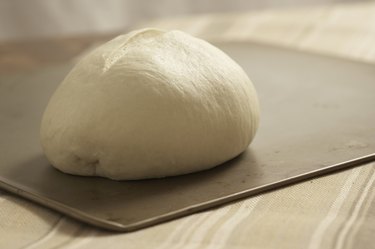
When you make a loaf of bread, time and yeast do most of the work for you. After kneading the dough, most recipes require you to let it rise at least once. For some breads, you need to let it rise twice. During the first rise, the dough ferments and develops flavor and volume. During the second rise, called proofing, the dough continues to ferment after you shape it into a loaf.
Texture and Taste
Video of the Day
If you let the dough rise for too long, the taste and texture of the finished bread suffers. Because the dough is fermenting during both rises, if the process goes on for too long, the finished loaf of bread can have a sour, unpleasant taste. The finished loaf usually also has a dense texture and isn't sufficiently chewy. Over-proofed loaves of bread have a gummy or crumbly texture.
Video of the Day
Collapsing Bread
Bread doughs that rise for too long also tend to be smaller than properly proofed loaves. A common symptom is to have the bread rise in the oven, only to collapse. Letting the dough rise for too long makes the structure of the bread weak, so it can't support itself. Over-proofed breads tended to be 20 percent smaller than breads that weren't allowed to rise for too long, advises "Cook's Illustrated."
Prevention
You can keep bread dough from over-rising or over-proofing. Follow the recipe's recommended rising time. If the recipe calls for letting the dough rise for 60 to 90 minutes, check on it after 60 minutes. Press into the dough with two fingers. If the area you pressed stays depressed, the dough has risen enough. If the area fills back in, you need to let the dough rise a bit more. You can also mark on the rising container where double the original volume of the dough is, so that you have visual marker for when the dough is the right size. Set a kitchen timer to remind you to check the dough at the appropriate time.
Rescuing Over-proofed Dough
If you've let your dough rise for too long, all is not lost. You can save the dough. After the second rise, punch the dough down to deflate it. Shape the dough back into a loaf and cover to keep it from drying out. Let the dough rise again for the time suggested in the recipe. Check on the dough at the end of the rising time, then bake as directed.